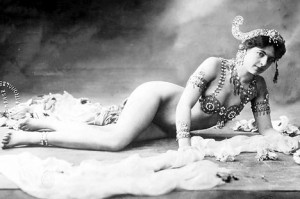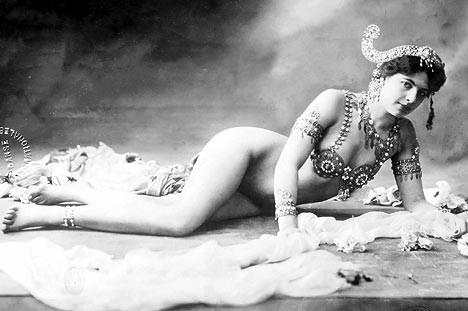
She first came to Paris in 1905 and found fame as a performer of exotic Asian-inspired dances. She soon began touring all over Europe, telling the story of how she was born in a sacred Indian temple and taught ancient dances by a priestess who gave her the name Mata Hari, meaning “eye of the day” in Malay. In reality, Mata Hari was born in a small town in northern Holland in 1876, and her real name was Margaretha Geertruida Zelle. She acquired her superficial knowledge of Indian and Javanese dances when she lived for several years in Malaysia with her former husband, who was a Scot in the Dutch colonial army. Regardless of her authenticity, she packed dance halls and opera houses from Russia to France, mostly because her show consisted of her slowly stripping nude.
She became a famous courtesan, and with the outbreak of World War I her catalog of lovers began to include high-ranking military officers of various nationalities. In February 1917, French authorities arrested her for espionage and imprisoned her at St. Lazare Prison in Paris. In a military trial conducted in July, she was accused of revealing details of the Allies’ new weapon, the tank, resulting in the deaths of thousands of soldiers. She was convicted and sentenced to death, and on October 15 she refused a blindfold and was shot to death by a firing squad at Vincennes.
In a black car with its window blinds down, Margaretha Zelle, convicted of espionage, was then driven at speed through the still streets of the capital – a place she loved with a passion, though she was Dutch not French.
The 12 soldiers in their khaki uniforms and red fezzes raised their rifles. She waved to the two weeping nuns who had been her comfort in prison and on her last journey. She blew a kiss to the priest and another to her lawyer, an ex-lover.
The sun was coming up when the shots rang out. Zelle slumped to the ground. The officer in charge marched forward and fired a single bullet into her brain, the coup de grace.
There is some evidence that Mata Hari acted as a German spy, and for a time as a double agent for the French, but the Germans had written her off as an ineffective agent whose pillow talk had produced little intelligence of value. Her military trial was riddled with bias and circumstantial evidence, and it is probable that French authorities trumped her up as “the greatest woman spy of the century” as a distraction for the huge losses the French army was suffering on the western front. Her only real crimes may have been an elaborate stage fallacy and a weakness for men in uniform.


